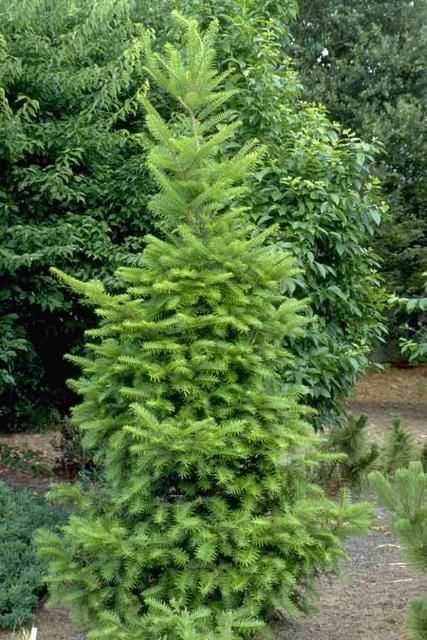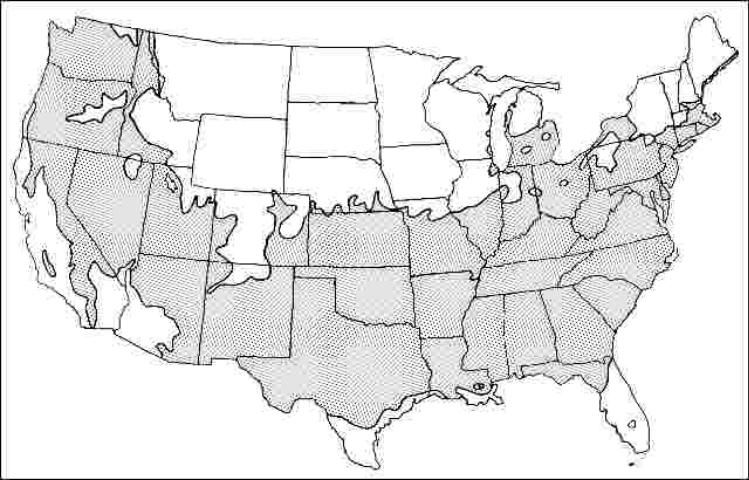Introduction
Japanese fir has a similar form to white fir, but has stiffer, medium to dark green needles and may grow taller. It probably grows 20 feet in 30 years. The trunk grows straight up the center of the tree and the crown maintains a soft, tight, pyramidal shape without pruning. Branches are held upright on young trees but give way to a more horizontal form as the tree grows older. The tree looks best with lower branches left on the tree so they sweep the ground. Growth is very slow in the seedling stage and after transplanting, but once established the tree will grow about 12 inches per year.

Credit: Ed Gilman
General Information
Scientific name: Abies firma
Pronunciation: AY-beez FEER-muh
Common name(s): Japanese Fir
Family: Pinaceae
USDA hardiness zones: 5B through 8B (Fig. 2)
Origin: not native to North America
Uses: Christmas tree; highway median; specimen; screen; Bonsai
Availability: not native to North America

Description
Height: 20 to 30 feet
Spread: 10 to 15 feet
Crown uniformity: symmetrical
Crown shape: pyramidal
Crown density: dense
Growth rate: slow
Texture: fine
Foliage
Leaf arrangement: spiral (Fig. 3)
Leaf type: simple
Leaf margin: entire
Leaf shape: needle-like (filiform)
Leaf venation: parallel
Leaf type and persistence: evergreen, needled evergreen
Leaf blade length: less than 2 inches
Leaf color: green
Fall color: no color change
Fall characteristic: not showy

Flower
Flower color: unknown
Flower characteristics: not showy
Fruit
Fruit shape: cone, elongated
Fruit length: 3 to 6 inches
Fruit covering: dry or hard
Fruit color: brown
Fruit characteristics: does not attract wildlife; not showy; fruit/leaves not a litter problem
Trunk and Branches
Trunk/bark/branches: branches droop; not showy; typically one trunk; thorns
Pruning requirement: little required
Breakage: resistant
Current year twig color: green
Current year twig thickness: medium, thick
Wood specific gravity: unknown
Culture
Light requirement: full sun
Soil tolerances: clay; sand; loam; acidic; well-drained
Drought tolerance: high
Aerosol salt tolerance: unknown
Other
Roots: not a problem
Winter interest: no
Outstanding tree: yes
Invasive potential: little invasive potential
Ozone sensitivity: unknown
Verticillium wilt susceptibility: resistant
Pest resistance: free of serious pests and diseases

Use and Management
It is used as a Christmas tree in the western United States, and should be tried in the East as a landscape plant and Christmas tree. Although rare in the nursery trade, Japanese fir is a beautiful plant making an outstanding specimen that should be grown and planted more often. It can be seen in a number of arboreta in the southern part of the country. Use it to create a slow-growing screen planted on 10-foot centers, or as a specimen.
Grown best in acid soil in the full sun, Japanese fir is surprisingly tolerant of heat and drought, even in clay soil (but allow for good drainage). It has not grown well in alkaline soil. It should be a low-maintenance tree requiring little or no fertilizer or irrigation. It is probably one of the best (if not the best) firs to grow in the Southeast.
Propagation is by seed.
Pests and Diseases
There are no reports of serious pest problems, although the tree has not been grown much or extensively tested in the East.